It looks like hamentashen, but it’s a croppen. Or kroppen. Neither Usem or Rosenbaum are certain how it’s spelled. They are also uncertain about its history outside of the family.
“It’s from Romania? Who knows? I wasn’t there,” said Rosenbaum. “I’ve been interested in it, but there’s nothing in Google or Epicurious or Jewish cookbooks.”
The recipe came from Rosenbaum and Usem’s grandmother, which they now bake with their children and grandchildren.
“You’re talking five generations that the recipe spans,” he said. “It’s kind of cool.”
The kroppen (or croppen) are made from a dough that is honey-based and then brushed with honey again after it’s baked.
“The making of the dough is very special and unique,” Usem said. “As far as we know, no one knows how to make it. Had they not taken the time to [teach us], we wouldn’t have it.
“The dough is the dough. It’s better than the average one that you can buy anywhere in our opinion. And others'”
So here’s the photo of the recipe:

It’s well used over the years and leaves things out like how to make them and how long to cook them. Some of that is easy, Rosenbaum said. The dough is rolled out and cut into strips about 1 ½ inches wide. The filling is placed in the middle strips are then rolled into the triangle – sort of how you’d fold a flag into a triangle.
Rosenbaum said that he bakes it at 375 degrees. For how long? Well, it’s complicated.
“There’s a conflict: Do you make it thick or thin? Too much or too little filling. Open or closed? Is it spelled with a ‘C’ or ‘K’?” he said. “Yours are wrong and mine are right.”
Said Usem: “I wish more people understood the importance of traditions.”

